Nationality Indian | Name Sai of | |
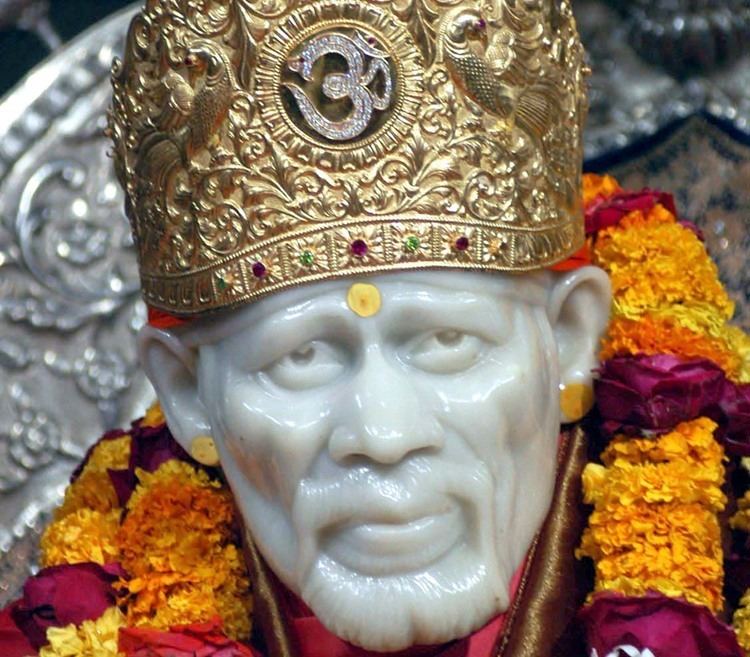 | ||
Philosophy Bhakti Yoga, Jnana Yoga, Karma Yoga, Self-Realization Notable disciple(s) Mhalsapati, Madhav Rao (peshway), Nanasaheb peshway, Tatya Patil, Kakasaheb Dixit, Hemadpant, Bhuti, Das Ganu, Lakshmi Bai, Nanavali, Upasni Maharaj, Abdul Baba Quotation Shraddha - Sabari (faith - patience) Similar People Sathya Sai Baba, Swami Samarth, Meher Baba, Gajanan Maharaj, Guru Nanak | ||
story of shirdi sai baba in hindi
Sai Baba of Shirdi, also known as Shirdi Sai Baba, was an Indian spiritual master who is regarded by his devotees as a saint, a fakir, a satguru and an incarnation (avatar) of Lord Shiva. He is revered by both his Hindu and Muslim devotees during, as well as after his lifetime.
Contents
- story of shirdi sai baba in hindi
- Background
- Early years
- Return to Shirdi
- Teachings and practices
- Worship and devotees
- Non Discrimination of Devotees
- Notable disciples
- Miracles
- Hinduism
- Zoroastrianism
- Sacred art and architecture
- Film and television
- References

According to accounts from his life, he preached the importance of realization of the self, and criticized love towards perishable things. His teachings concentrate on a moral code of love, forgiveness, helping others, charity, contentment, inner peace, and devotion to the God and guru. He stressed the importance of surrender to the true Satguru, who, having trod the path to divine consciousness, will lead the disciple through the jungle of spiritual training.
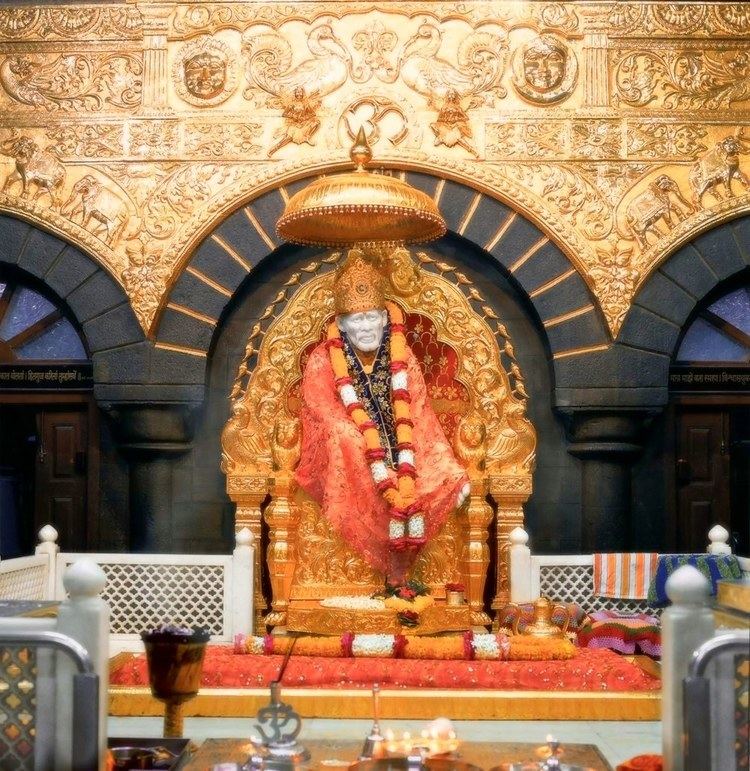
Sai Baba also condemned distinction based on religion or caste. It remains unclear if he was a Muslim or a Hindu. This, however, was of no consequence to Sai Baba. His teaching combined elements of Hinduism and Islam: he gave the Hindu name Dwarakamayi to the mosque in which he lived, practised both Hindu and Muslim rituals, taught using words and figures that drew from both traditions, and took samadhi in Shirdi. One of his well-known epigrams, Allah Malik (God is King) and Sabka Malik Ek (One God governs all), is associated with both Hinduism and Islam. He is also known to have said Look to me, and I shall look to you.
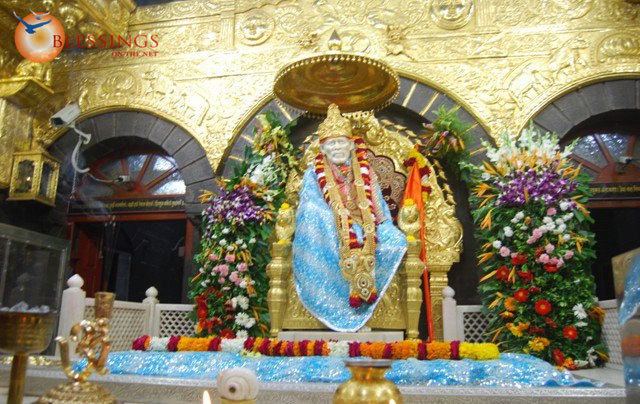
Background
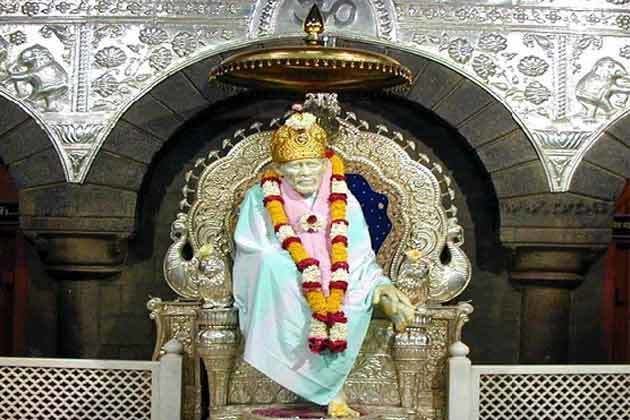
Sai Baba's date of birth including his birthplace remains unknown and is debatable due to lack of evidence and no definitive information exists to prove it.
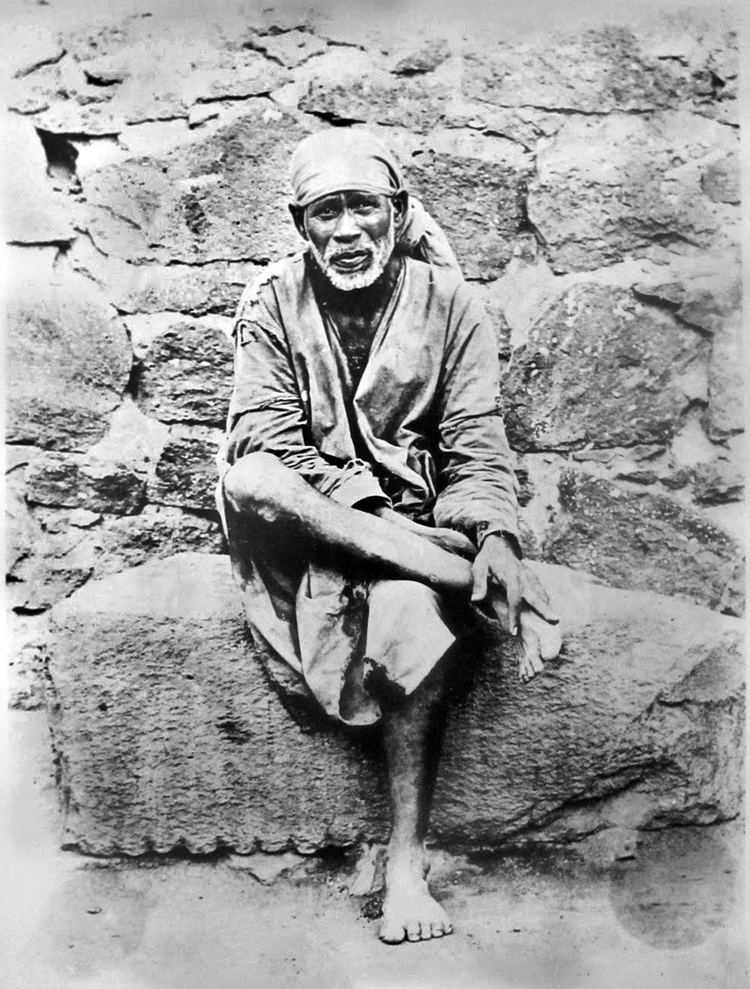
Sai Baba's real name remains unknown. The name 'Sai' was given to him by Mhalsapati when he arrived at Shirdi, a town now in the west Indian state of Maharashtra. The word 'Sai' refers to a religious mendicant but can also mean 'God'. In several Indian and Middle Eastern languages the term 'Baba' is an honorific signifying grandfather, father, old man or sir. Thus Sai Baba denotes holy father, saintly father or (venerable) poor old man.
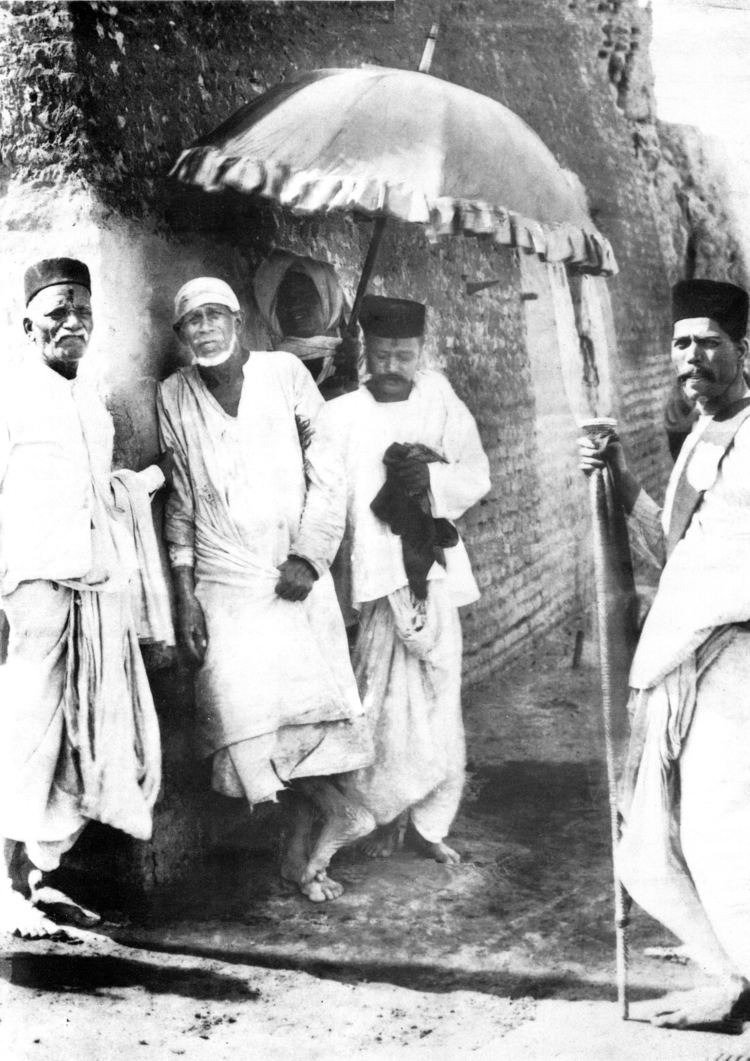
Some of Sai Baba's disciples became famous as spiritual figures and saints, such as Mhalsapati, a priest of the Khandoba temple in Shirdi, and Upasni Maharaj. He was revered by other saints as well, such as Saint Bidkar Maharaj, Saint Gangagir, Saint Janakidas Maharaj, and Sati Godavari Mataji. Sai Baba referred to several saints as 'my brothers', especially the disciples of Swami Samartha of Akkalkot.
Early years
According to the book Sai Satcharita, Sai Baba arrived at the village of Shirdi in the Ahmednagar District, British India when he was about 16 years old. He led an ascetic life, sitting motionless under a Neem tree and meditated while sitting in an Asana. The Shri Sai Satcharita recounts the reaction of the villagers:
The people of the village were wonderstruck to see such a young lad practicing hard penance, never minding the heat or cold. By day he associated with no one, by night he was afraid of nobody.
His presence attracted the curiosity of the villagers, and he was regularly visited by the religiously inclined, including Mahalsapati, Appa Jogle and Kashinatha. Some considered him mad and threw stones at him. Sai Baba left the village, and little is known about him after that.
There are some indications that he met with many saints and fakirs, and worked as a weaver. He claimed to have been with the army of Rani Lakshmibai of Jhansi during the Indian Rebellion of 1857. It is generally accepted that Sai Baba stayed in Shirdi for three years, disappeared for a year, and returned permanently around 1858, which suggests a birth year of 1838.
Return to Shirdi
Sai Baba returned to Shirdi in 1858. He appeared at the Khandoba Mandir in Shirdi. The temple priest, Mhalsapati, upon seeing him for the very first time, welcomed him by saying 'Aao, Sai!' ('Come Sai'). From then on, He was known by the name (Sai Baba).
Around this time he adopted his famous style of dressing, consisting of a knee-length one-piece Kafni robe and a cloth cap. Ramgir Bua, a devotee, testified that Sai Baba was dressed like an athlete and sported 'long hair flowing down to the end of his spine' when he arrived in Shirdi, and that he never had his head shaved. It was only after Baba forfeited a wrestling match with one Mohiddin Tamboli that he took up the kafni and cloth cap, articles of typical Sufi clothing. This attire contributed to Baba's identification as a Muslim fakir and was a reason for initial indifference and hostility against him in a predominantly Hindu village.
For four to five years, Baba lived under a neem tree and often wandered for long periods in the jungle around Shirdi. His manner was said to be withdrawn and uncommunicative as he undertook long periods of meditation. He was eventually persuaded to take up residence in an old and dilapidated mosque and lived a solitary life there, surviving by begging for alms, and receiving itinerant Hindu or Muslim visitors. In the mosque he maintained a sacred fire which is referred to as a dhuni, from which he gave sacred ash ('Udi') to his guests before they left. The ash was believed to have healing and apotropaic powers. He performed the function of a local hakim and treated the sick by application of ashes. Sai Baba also delivered spiritual teachings to his visitors, recommending the reading of the Ramayan and Bhagavat Gita for Hindus and Qur'an for Muslims. He insisted on the indispensability of the unbroken remembrance of God's name (dhikr, and often expressed himself in a cryptic manner with the use of parables, symbols and allegories.
Baba is known to have grown, nurtured and cultivated a garden called "Lendi Baug". during his lifetime. The garden was watered daily by Baba himself. Lendi Baug got its name from a well known river which used to previously flow there. The garden was full of trees and flowering plants that included a rose garden where deer and rabbits roamed about. Baba went to Lendi Baug daily and every day he threw some silver coins in the 'Lendi' ('Well'). Baba was also known to test his devotees to see if they hankered after money and gold. Baba used to come here every morning and afternoon entering alone through the west and rest under a Neem tree. Sai Baba also dug a pit, 2 feet deep, under the Neem tree and kept an earthen lamp lit continuously. Lendi Baug also has a well which was dug by Baba and his devotees.
After 1910, Sai Baba's fame began to spread in Mumbai. Numerous people started visiting him, because they regarded him as a saint with the power of performing miracles or even as an avatar. They built his first temple at Bhivpuri, Karjat.
Teachings and practices
Sai Baba opposed all persecution based on religion or caste. He was an opponent of religious orthodoxy — Christian, Hindu and Muslim.
Sai Baba encouraged his devotees to pray, chant God's name, and read holy scriptures. He told Muslims to study the Qur'an and Hindus to study texts such as the Ramayana, Bhagavad Gita, and Yoga Vasistha. He was impressed by the philosophy of the Bhagavad Gita and encouraged people to follow it in their own lives. He advised his devotees and followers to lead a moral life, help others, love every living being without any discrimination, and develop two important features of character: devotion to the Guru (Sraddha) and waiting cheerfully with patience and love (Saburi). He criticised atheism.
In his teachings, Sai Baba emphasised the importance of performing one's duties without attachment to earthly matters and of being content regardless of the situation. In his personal practice, Sai Baba observed worship procedures belonging to Islam; he shunned any kind of regular rituals but allowed the practice of Salah, chanting of Al-Fatiha, and Qur'an readings at Muslim festival times. Occasionally reciting the Al-Fatiha, Baba enjoyed listening to mawlid and qawwali accompanied with the tabla and sarangi twice daily.
Sai Baba interpreted the religious texts of both Islam and Hinduism. He explained the meaning of the Hindu scriptures in the spirit of Advaita Vedanta. His philosophy also had numerous elements of bhakti. The three main Hindu spiritual paths — Bhakti Yoga, Jnana Yoga, and Karma Yoga — influenced his teachings.
Sai Baba encouraged charity and stressed the importance of sharing. He said
Unless there is some relationship or connection, nobody goes anywhere. If any men or creatures come to you, do not discourteously drive them away, but receive them well and treat them with due respect. Sri Hari (God) will certainly be pleased if you give water to the thirsty, bread to the hungry, clothes to the naked, and your verandah to strangers for sitting and resting. If anybody wants any money from you and you are not inclined to give, do not give, but do not bark at him like a dog."
Worship and devotees
The Shirdi Sai Baba movement began in the 19th century, while he was living in Shirdi. A local Khandoba priest, Mhalsapati Nagre, is believed to have been his first devotee. In the 19th century, Sai Baba's followers were only a small group of inhabitants of Shirdi, and a few people from other parts of India.
Because of Sai Baba, Shirdi has become a place of importance and is counted among the major Hindu places of pilgrimage. The first Sai Baba temple is situated at Kudal, Sindhudurg. This temple was built in 1922. It is believed that Sai Baba gave one Rupee to Dada Madye ji with which he built the temple in Kudal.
Today, The Sai Baba Temple in Shirdi is visited by an average of 25,000 pilgrims a day, and during religious festivals, this number can reach up to 1,00,000. The Sai Baba temple in Shirdi is managed by the Shri Sai Baba Sansthan Trust. Inside the temple, The statue of Sai Baba and the Samadhi is carved out of Italian marble and is seen draped with royal cloth, wearing a gold crown and adorned with fresh flower garlands.The interior, as well as the exterior (cone) of the temple, is covered with gold. As per rituals and traditions dating back to when Baba was still alive, Four Aarti's are held daily (corresponding to the time of the day) inside the Samadhi Mandir.
The Palanquin procession of Sai Baba takes place every Thursday from the Samadhi Mandir to Dwarkamayi, onward to Chavdi and back to the Sai Baba Mandir. Devotees belonging to all faiths are welcome to take Darshan in the Samadhi Mandir and have free meals in the Prasadalaya, irrespective of caste, creed, and religion as these were one of the ideal principles of Sai Baba.
Sai Baba of Shirdi is especially revered and worshiped in the states of Maharashtra, Odisha, Andhra Pradesh, Telangana, Karnataka, Tamil Nadu and Gujarat. In August 2012, an unidentified devotee, for the first time, donated two expensive diamonds valuing ₹11.8 million at the Shirdi temple, as revealed by Saibaba trust officials.
In recent years, the Shirdi Sai movement has spread to the Caribbean and to countries such as the Nepal, Canada, United States, Australia, United Arab Emirates, Malaysia, United Kingdom, Germany, France and Singapore.
Non-Discrimination of Devotees
Baba himself maintained an ambiguous profile, unwilling to identify with either of the two religions. His Muslim devotees were fully convinced that he belonged to their fold, identifying him as an avaliā. The Hindu bhaktas also viewed him as one of them, since he often identified himself with their gods and customs. Sai Baba wanted to belong to all and be shared by all. When pressed on whether he was Hindu or Muslim, he would often get very angry and abuse people. Once he told a devotee: "You have been with me for eighteen years now. Does Sai mean for you only these three and a half cubits of height?" Sai Baba was able to avoid clashes between the two communities, and, in fact, succeeded in unifying them in an atmosphere of general harmony. In a verse of the midday arti, devotees sing:
"In essence or basic principle, there is no difference whatever between Hindu and Muslim. You took birth in human body to point out this. You look with affection on both Hindus and Muslims. This, Sai, who pervades all, as the soul of all, shows."
Baba would often talk about the Hindu gods, quoting from sacred texts or even commenting upon passages of the Bhagavadgita, the Isha Upanishad, and so forth. The names of Krishna and Rama seem to have been particularly dear to him. With his Muslim followers, Baba would always talk of Allah and the Koran, often quoting Persian verses. One of his favorite expressions was "Allah rakhega vaiia rahena", that is, "Let us be content with what we have, and submit our will to Allah." On several occasions, Sai reassured his listeners by saying that he, like them, was but a devotee of Allah, a humble faqir with two arms and two legs. In later years, Parsis and even a few Christians would come to Shirdi. Sai Baba respected all creeds, true to his conviction that all religions are but particular paths leading to one ineffable goal.
His notion of the unity of all mankind that appealed to everyone was very congruous with Sufi Islam. "God being one and the master of all also meant that all his creatures were part of one big family," writes Sikand. "This belief was entirely in keeping with ... the teachings of Sufis, who believed that the light of God exists in every creature, indeed in every particle of His creation." Sai Baba urged his Hindu followers to read their holy books and find their own path. For him, all paths were equally valid, "Ishwar" (the Hindu God) and "Allah" being synonymous. People coming to his abode were so taken aback to see Hindus, Muslims, and others living together so peacefully that in many in-stances it changed their entire lives and belief systems.
Notable disciples
Sai Baba left behind no spiritual heirs, appointed no disciples, and did not provide formal initiation (diksha), despite requests. Some disciples of Sai Baba achieved fame as spiritual figures, such as Upasni Maharaj of Sakori. After the demise of Sai Baba, his devotees offered the daily Aarti to Upasni Maharaj when he paid a visit to Shirdi twice within 10 years.
Miracles
Sai Baba's disciples and devotees claim that he performed many miracles such as bilocation, levitation, mindreading, materialisation, exorcisms, entering a state of Samādhi at will, lighting lamps with water, removing his limbs or intestines and sticking them back to his body (khandana yoga), curing the incurably sick, appearing beaten when another was beaten, preventing a mosque from falling down on people, and helping his devotees in other miraculous ways. He also gave Darshan (vision) to people in the form of Sri Rama, Krishna, Vithoba, Shiva and many other gods depending on the faith of devotees.
According to his followers, he appeared to them in their dreams and gave them advice. His devotees have documented many stories.
Hinduism
During Sai Baba's lifetime, the Hindu saint Anandanath of Yewala declared Sai Baba to be a "spiritual diamond." Another saint, Gangagir, also called him a "jewel." Sri Beedkar Maharaj greatly revered Sai Baba, and in 1873, when he met him he bestowed the title Jagad guru upon him. Sai Baba was also greatly respected by Vasudevananda Saraswati (known as Tembye Swami). He was also revered by a group of Shaivic yogis, known as the Nath-Panchayat. He is considered an avatar of the Supreme Reality (Brahman or God), a satguru, or saint, depending on individual proclivities. This is not uncommon in Hinduism where there is no central doctrine or cosmology, but a basis in individual faith and spirituality.
Zoroastrianism
Saibaba was revered by prominent Zoroastrians such as Nanabhoy Palkhivala, Farhaad Panthaky and Homi Bhabha, and has been cited as the Zoroastrians' most popular non-Zoroastrian religious figure.
Meher Baba, who was born into a Zoroastrian family, met Sai Baba once, during World War I, in December 1915. This event is considered as the most significant in Meher Baba's life. Shri Sai Satcharita (Sai Baba's life story), makes no mention of Meher Baba but Lord Meher, the life story of Meher Baba, there are numerous references to Sai Baba.
Meher Baba, who claimed he was an (the) Avatar, credited his Avataric advent to Upasni, Sai Baba, and three other Perfect Masters: Hazrat Babajan, Hazrat Tajuddin Baba, and Narayan Maharaj. He declared Sai Baba to be a Qutub-e-Irshad (the highest of the five Qutubs, a "Master of the Universe" in the spiritual hierarchy). This classification of avatar and satgurus and the associated name is applied within the Meher Baba community alone.
Sacred art and architecture
There are many temples of Sai Baba in India. Temples are also located in countries outside India, including the United States, Netherlands, Kenya, Benin, Cuba, Canada, Pakistan, Australia, United Kingdom, Germany and Japan. Present in the mosque in Shirdi in which Sai Baba lived, is a life-size portrait of him by Shama Rao Jaykar, an artist from Mumbai. Numerous monuments and statues depicting Sai Baba which serve a religious function have been made. One of them, made of marble by a sculptor named Balaji Vasant Talim, is in the Samadhi Mandir in Shirdi where Sai Baba was buried.
In 2008, India Post has issued a commemorative postage stamp of ₹5.00 to honour Sai Baba.
Film and television
Sai Baba has been the subject of several feature films in many languages produced by India's film industry.
